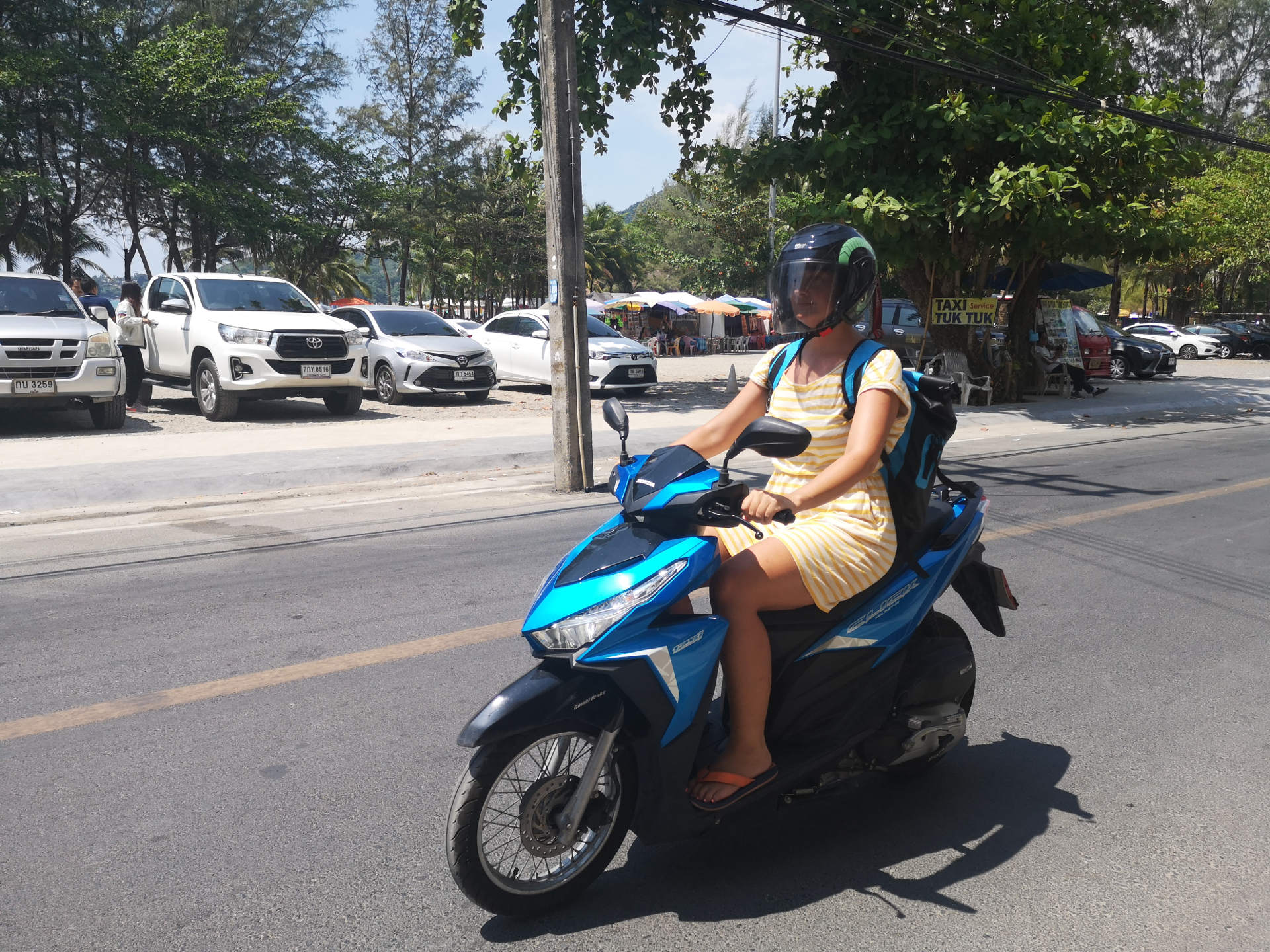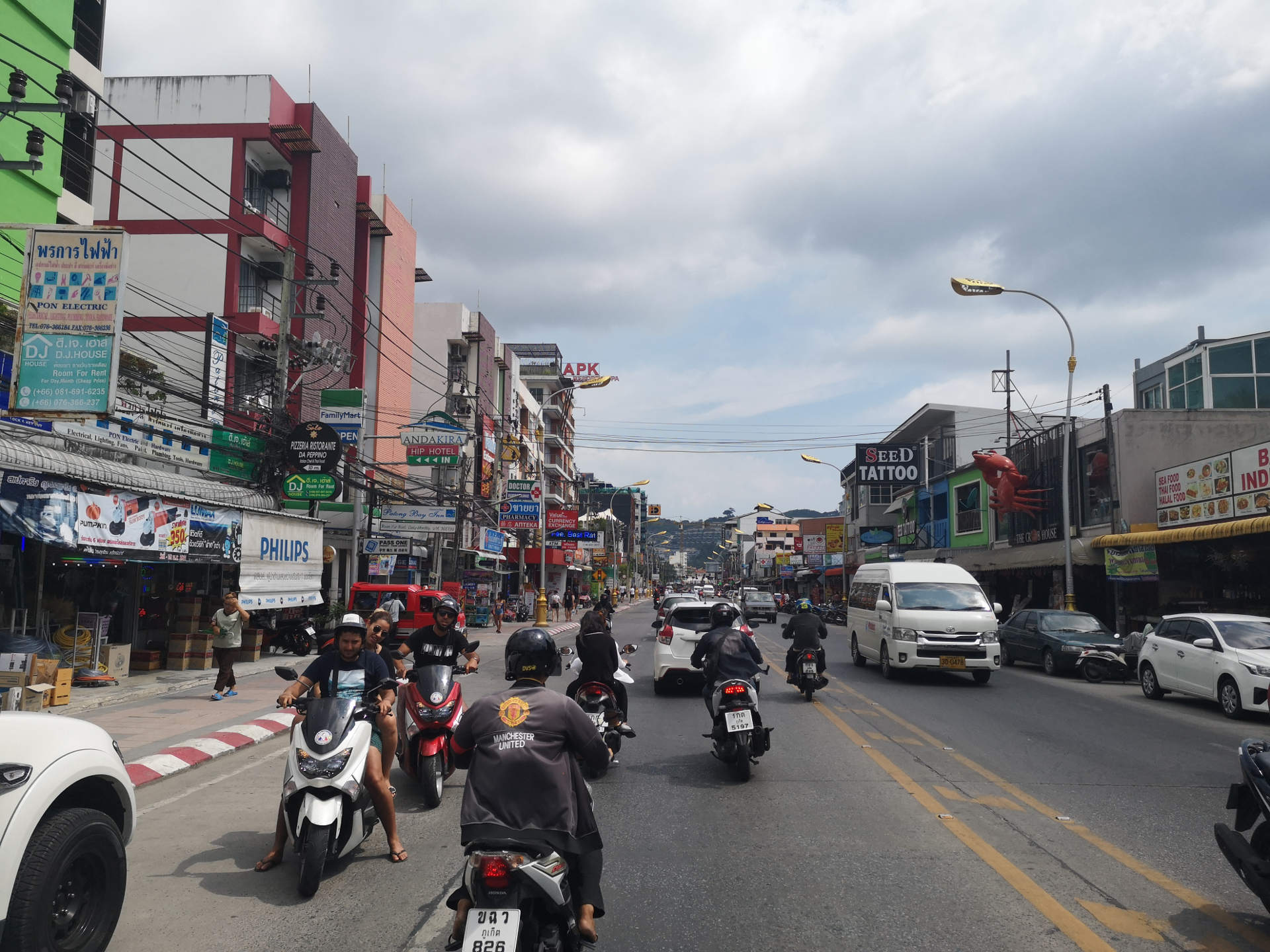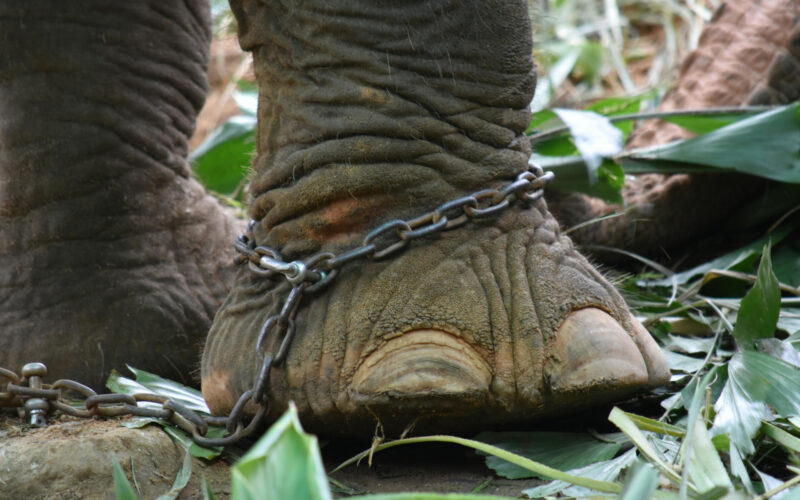When I arrived in Phuket, I was convinced of one thing: “I will never ride a scooter here!”
On the one hand, this was due to the fact that I had never ridden on a moped or motorcycle in my life, let alone driven one myself. Motorized two-wheeled vehicles had always been foreign to me. It started when I was 16, when my classmates got their moped licenses (and I didn't want to at all), and it didn't change until I arrived in Phuket at the age of 36.
Nun hat man aber auf Phuket bei einem Longtime-Aufenthalt ein entscheidendes Problem: Die Strecken sind weit, und Taxis und Tuktuks sind teuer. Vor allem auf Dauer. Und das wiederum bedeutet, dass man an den Ort, in dem man wohnt, gefesselt ist, so wie ich an Patong Beach. Wer schon mal in Patong Beach war weiß, dass das kein erstrebenswerter Zustand ist.
Riding mopeds and scooters in Thailand – and surviving
My start as a scooter rider
At the end of December, the time had come for me too: I wanted a motor scooter. Simply to have freedom of movement and be able to go anywhere I wanted, whenever I wanted. So I borrowed a Honda Click, just for one day. The Click has 125cc, so it's quite powerful. It's no longer a moped.
Helm auf, raufgesetzt, festgestellt wie das mit dem Bremsen und vor allem auch mit dem Gasgeben läuft (am Handgriff drehen) und mir jemanden organisiert, der mit mir seinem eigenen Motorroller vorgefahren ist, damit ich mich nicht so stark auf andere Verkehrsteilnehmer konzentrieren musste.
Oh by the way, did I mention that Thailand drives on the left?
Well, my first trip to the beach was a rather uncertain and shaky affair. My second trip on a scooter I rented by the day was better. And my third trip was on my “own” Honda Click, which I borrowed for a longer period of time. And from then on, I was totally hooked. Riding a scooter has almost become a hobby for me, and I really enjoy it. I also like to ride pretty fast.
But Thailand's roads are not without their dangers, and many tourists don't want to rent a scooter because it's too dangerous, and with good reason. However, it's not the “wild Thais” who make it dangerous, but rather the clueless tourists. Because even though it looks like pure anarchy reigns on the roads, everything actually runs in a very orderly chaos.
My top tips for riding scooters and mopeds in Thailand
Wie sieht es beim Fahren auf Phukets Straßen aus? Seht euch hier das Video auf YouTube dazu an!
Tip 1: Get an international driver's license
Hier in Thailand braucht man keinen Motorradführerschein oder Kleinmotorrad-Zusatz zum B-Führerschein, um sich ein entsprechend motorisiertes Zweirad ausborgen zu können. Für das Ausborgen selbst ist meistens nicht mal der Führerschein, sondern nur der Reisepass vonnöten. ABER: Wer in einer Polizeikontrolle landet und keinen bzw. nur den nationalen Führerschein vorweist, wird umgehend zur Kassa gebeten. Deshalb am besten noch vor Abreise in den Urlaub daheim einen internationalen, ein Jahr gültigen Führerschein ausstellen lassen. In Österreich geht das z.B. bei ÖAMTC und ARBÖ. Man braucht dafür nur den eigenen Führerschein und ein aktuelles Passfoto mitbringen. Im Urlaub muss man dann immer beide Ausweise gemeinsam vorweisen.
By the way, having at least a small motorcycle license is worth something. Keyword: insurance! And having practiced riding with a driving instructor is also a good thing.
Tip 2: Don't hand over your passport
Many rental companies ask for your passport as security. Never hand over your passport! Not that it would get lost there, but your passport is your most important document when abroad and has no place in the hands of strangers.
Therefore, bring a colored copy of your passport with you from the outset and offer it to them. If the rental company insists on seeing your original passport, go to the next rental shop—there are plenty of them in Phuket. It's best to check the reviews on Google Maps—that always works well for me.
When borrowing the scooter, don't forget to take detailed photos or videos of it from all sides, especially where there is existing damage.
Bei meiner letzten Anmietung habe ich ein Video vom Roller angefertigt, wo ich ihn komplett rundherum abgefilmt habe mit Fokus auf bestehende Schäden. Dieses Video habe ich per WhatsApp an die Vermieterin geschickt. So hatten wir einen gleichen Stand, der uns beiden als Beweis dienen konnte. Das fand ich eine ausgezeichnete Vorgehensweise.
Tip 3: Learn to drive – and not immediately on the main traffic route
I thought about it, but then I was too unmotivated to do it: adding “small motorcycle” to my regular driver's license, which would have meant two driving lessons and a new driver's license. If you feel the same way and are coming to Thailand without ever having ridden a moped before, then find a very quiet area or road to start with and practice a little. Riding is really not rocket science; after two or three rides, everything will be smooth sailing.
Nevertheless, driving on the left is something to be aware of, as it often poses a challenge. Driving normally is fine, but when you have to react quickly (for example, to swerve out of the way), those of us who are used to driving on the right tend to swerve immediately to the right—and that can quickly lead to dangerous situations.
(Ein Nachtrag von 2025: Den Kleinmotorrad-Führerschein besitze ich inzwischen, weil mich das Rollerfahren in Thailand so begeistert hat, dass ich mir in Österreich ebenfalls einen Roller zugelegt habe!)
Tip 4: Wear a helmet
It sounds trivial, but it's one of the most important tips of all. Wear a helmet when riding, and if there are two of you on the moped, please both wear helmets!
In principle, helmets are compulsory in Thailand for moped drivers, but not for passengers. So if you are a man and the driver, it won't help you at all if you kindly give your girlfriend the only helmet on the pillion seat during a police check: you will definitely be asked to pay a fine. The police here make really good money from tourists who don't wear helmets.
Incidentally, you will see many Thai people riding without helmets. They are also required to wear helmets, but the police naturally turn a blind eye to them. After all, there are enough tourists who are willing to pay the fines.
Apart from police checks and fines, there is something much more important: your life. And believe me, serious accidents involving mopeds are not the exception but the rule here on Phuket's roads. I have seen a lot of blood on the roads in recent months. Please don't let it be yours! Yes, it's hot here, and yes, riding without a helmet is really comfortable. But is it worth the risk?
So: Get yourself a helmet! You can borrow one free of charge when you hire the moped – and make sure you use it! This applies to all moped riders!
Übrigens: Wer den Leihhelmen nicht vertrauen will kann sich um wenig Geld einen eigenen, besseren Helm kaufen. Das hat den Vorteil, dass vor euch noch keiner hineingeschwitzt hat, und den zweiten Vorteil, dass ihr besser geschützt seid. Ich habe meinen Helm mit Vollvisier um rund THB 1.400,– gekauft, also wirklich keine große Investition.

Tip 5: Traffic rules and their variables
In principle, the traffic rules here are pretty much the same as ours, just reversed to the other side of the road.
The most important difference is that here you can turn left at any time even when the traffic light is red, but of course you must give way to vehicles coming from the right.
Speaking of red lights: some locals don't really care about them. Please don't follow their example, but stick to the usual color code, otherwise things can quickly become dangerous here.
Overtaking is generally done on the right here, but this only applies to cars. Mopeds usually overtake cars on the left, but each other on the right – unless the right side is full and there is plenty of space on the left.
Ihr seht schon, das ist nicht so einfach. 😅
There are numerous speed limits here, but no one sticks to them. It is not uncommon for people to drive at 80+ km/h on a well-maintained road with a 50 km/h limit. So don't worry too much about it. I would say that the recommended speed is what the locals drive at – but in most cases, that is very fast. So take your time (you're on vacation!) and drive at a speed that is comfortable and controllable for you. If this means you are slower than everyone else on the road, please keep to the left.
Weaker road users such as pedestrians do not have right of way here, at least not in real life. Pedestrians always wait until motorized vehicles have passed. I'm not saying that you don't have to brake for pedestrians... if only because the drivers behind you don't expect you to stop for pedestrians and may have to brake sharply.
However, be careful, as not all pedestrians know that they have to give way (especially Chinese pedestrians).
Tip 6: Find a lane – and stay there!
This is actually the most important tip and the reason why tourists in particular make the roads so dangerous, even though they usually drive more cautiously than the locals.
The road is single-lane – but only for cars, which are very wide. From a moped's perspective, a road lane has approximately three possible lanes parallel to each other in the same direction.
And – this is important – choose one and STAY THERE. It's not like at home, where road users stay in line and everyone can use the full width of the road. If you swerve from left to right and right to left, it can quickly become dangerous because other moped riders will want to overtake you.
So if you are driving in the middle lane and want to continue straight ahead, stay in the middle lane! If you want to overtake the car in front of you and have to move to the left side of the road to do so, don't just check your rear-view mirror, but also use the much-vaunted shoulder check.
Please remember that – that is really the most important rule for ‘safe’ moped riding here in Thailand!

Tip 7: Observe and learn
If you pay close attention to how the locals drive while you are on the road yourself, you will quickly see how orderly the apparent chaos on the road actually is. This will help you adapt very quickly. This applies to all aspects of driving, from keeping your lane to overtaking and how you behave towards other road users.
Tip: Even on very well-maintained roads where everyone is speeding along at 70 to 80 km/h, you may suddenly find that the next bend is so tight that you can only just make it through at 30 km/h. So if all the other cars and motorbikes are slowing down before a bend, there is usually a reason for it. Always keep a close eye on the other drivers!
Tip 8: Wrong-way drivers
Ihr werdet in anderen Berichten über das Mopedfahren oftmals lesen, dass euch Geisterfahrer entgegenkommen können. Das ist aber nicht so schlimm wie es klingt. Es handelt sich dabei nämlich üblicherweise um (einheimische) Mopedfahrer, die auf eurer Spur ganz links in die falsche Richtung fahren. Das kommt oft vor, und zwar dann, wenn die Fahrer nur ein kleines Stück zurück in eure entgegensetzte Richtung müssen (zum Beispiel um abzubiegen) und dafür nicht extra auf ihre eigene Spur fahren und dann wieder rechts abbiegen wollen.
These wrong-way drivers stay on the far left side of the road (i.e. their own right side) and only drive short distances, usually at slow speeds. So don't be alarmed if you see this, just drive past them – they won't endanger you.
Übrigens, wenn ihr mal an eurem Ziel vorbeigedüst seid, ist das auch für euch eine recht praktische Möglichkeit. Seid aber vorsichtig und macht es nur, wenn auf der Straße, auf der ihr seit, genügend Platz ist. Ob euch eine Polizeistreife dafür strafen würde, kann ich euch aber nicht sagen. Wenn ihr die Füße am Boden habt und dahinrollt, vermutlich nicht (aber ich übernehme keine Garantien).
Tip 9: Consider where you park
This tip has nothing to do with your driving, but is purely practical advice on where you can park – and where/when I would advise against it.
Mopeds can be parked almost anywhere. If you see several mopeds parked on the side of the road, simply park yours next to them without wasting too much space.
Caution: If the kerb is painted red/white, this means ‘no parking’, so please do not park there!
When parking in front of shops, please only park in front of those shops or restaurants that you are visiting, otherwise you will be blocking the parking spaces for their customers. However, if there is space available, you can park between shops so that you are not actually parked in front of either one.
Und bitte auch Taxi- und Tuktuk-Standplätze frei halten!
I strongly advise against parking near Bangla Road in Patong in the evening. The ‘extended’ Bangla Road, i.e. Soi Sansabai and Beach Road, is very popular with mopeds in Patong Beach. If you arrive early and come back at night and want to drive home, you may first have to laboriously dig your scooter out from three rows of other mopeds parked in front of it. In addition, your moped may have been moved, so it may not be exactly where you parked it. Finally, many people are not exactly gentle with your two-wheeler when they spot a possible parking space. I once left my scooter on Sansabai for one night and the next day I had a few scratches in the paintwork – for which the rental company then kindly asked me to pay. It's not worth it.
Ganz ehrlich – wenn man abends zur Bangla Road will, ist es sowieso besser, das Moped gar nicht erst anzugreifen, sondern bis zum nächsten Tag und bis nach der Ausnüchterung komplett stehen zu lassen.
Tip 10: Honking as a form of communication
Here in Thailand, honking is an important form of communication – similar to what we are familiar with in Italy.
The horn is used in the following situations:
- Classic honking – you alert another driver that they have just almost caused an accident, or that they should please not act so stupidly.
- One driver knows another driver and says hello.
- ‘Hello, here I am, and I'm driving now’: Are you coming out of a blind side street or a car park? Honk your horn if you are not clearly visible. Pay particular attention to other people who honk their horns and suddenly drive out of a blind spot.
- Honk to draw attention to yourself, for example when you want to overtake and need to alert the driver in front of you.
Tip 11: Flashing the lights is not always customary
You will notice this yourself when driving: because you cannot hear the ‘indicator sound’ on a moped, as you can when driving a car, you constantly forget to turn off the indicator. This is not only the case for you, but also for all other moped drivers, tourists and even some locals. So if someone is constantly indicating left, they have probably forgotten to turn off their indicator. However, that doesn't mean that they don't want to turn left at the next traffic lights. So caution is advised.
At the same time, however, the opposite is true when it comes to changing lanes or similar manoeuvres: locals only use their indicators very rarely.
Finally, hazard warning lights are also very popular. They can mean the following:
- I have to brake sharply.
- I'll let you (pedestrian) cross the road or you (moped rider) drive out of the intersection.
- I certainly won't let you (pedestrian) cross the road, and I definitely won't let you (moped rider) cross either.
Alles klar, oder? 😄
So, I've now gathered all the tips I want to give you as a new driver in Thailand. As a general rule, just be careful and don't throw all the usual traffic rules out the window just because you're on holiday. Drive safely and always pay attention to everything going on around you, and you'll have many great trips in Thailand. 🙂






Hallo, danke für die super Tipps.
eine Frage habe ich noch:
Wie ist es mit Moped fahren am Abend/Nacht?
Wir sind etwas abgelegen vom Schuss und müsste nach dem Abendessen oder Fortgehen nach Hause fahren, ist das sehr gefährlich?
liebe Grüße
Stefanie
Abends wird der Verkehr weniger, zumindest war das auf Phuket immer so. Ich bin auch einige Male abends und Nachts gefahren und hatte keine Probleme. Natürlich checken, ob auf eurem Roller die Lichter funktionieren und mehr Vorsicht walten lassen. Aber sonst solltet ihr keine Probleme haben!
Fahrt vorsichtig und viel Spaß!